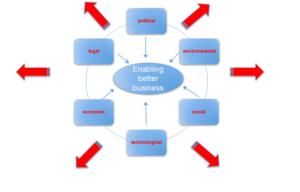When I work with leaders as an executive coach to expand their leadership capacity by being, thinking and leading in a transformational way at some point we discuss the internal and external saboteurs. What gets in the way of delivering business results in accordance with the desired vision in the continuously changing and complex business environment of today world?
One of the interesting topics ‘Barriers to breakthrough in performance’ – brought to us by Cliff Kimber, CHN presenter in May -, inspired me the most as it pretty much resonates with the work I do in the field of Transformational Leadership.
According to Cliff the barriers to breakthrough in performance are often embedded in the environment (eco-system) where we need to perform the most, therefore it is key for us as coaches and leaders to explore this arena in order to make a shift. Simply put: the most important questions to be answered: ‘What is the context we are operating in and where are we barrier blind?’
In every environment or eco-system, no matter how seamless the flow is, there are and there will be barriers to breakthrough in performance. These could be physical, psychological, structural, behavioural or cultural. There are and will be ’rules’ real, imagined, construed (interpreted and understood), misconstrued!
As leaders and coaches in business understanding that these barriers exist in all areas is critical to facilitate transformation in performance and enable better business.

PESTEL is a tool or framework used for marketers. It is an acronym which consists of 6 macro-environmental factors that influence business performance. They are political, economic, social, technological, environmental and legal. You should not see these components as independent factors. They are all interdependent. For example, technological advances can affect the economy in different markets.
If the components in your eco system are not in line with you strategic intent, if there’s any incongruence you will build a barrier to breakthrough in performance (red arrows). When there are these barriers, real or imagined, we start to see a decline in performance.
If you want to work on this you have to start by writing down where you construe the barriers to your breakthrough to be. Make a list of these barriers. Then categorise those in the 6 areas where you think they best. That is the place where you need to either do a deep inner work with your coach or have a discussion with your team.
Acknowledgement is the first step in the process and understanding how the barrier is construed or appeared is useful e.g.
- is it a design flaw in the structure (overlapping territories can result duplication of work, and generate unhealthy competition),
- is it inherent in the system (that is the way we used to do things here), or
- is it a cultural thing (blaming others, there is always others’ fault)?
How we start to understand the barriers to breakthrough in performance are closely linked to psychologist George Kelly’s fundamental theory; ‘A persons processes are psychologically channelized by the way they anticipate events’. Means our processes (thoughts, feelings, and actions) are not so much responses to something, rather they are indicators of anticipation, so about what’s next. People build assumptive worlds and act accordingly’. As leaders and coaches we are working with anticipation and assumption all of the time.
We need to challenge our assumptions and expand our anticipations:
- How are you anticipating things?
- What would happen if you anticipate it differently?
- What else could happen?
We don’t even think that in a situation that has been previously seen rather negative has so many possibilities. That’s also refer to all the barriers we may face. We only have try to better understand them. The best and most handy armour of a leader in the operation is his/her self-awareness.
You can read my original article on the topic in Hungarian at Forbes.hu: https://forbes.hu/legyel-jobb/hogyan-legyel-sikeresebb-ismerd-meg-a-korlataidat/
Source: Cliff Kimber

